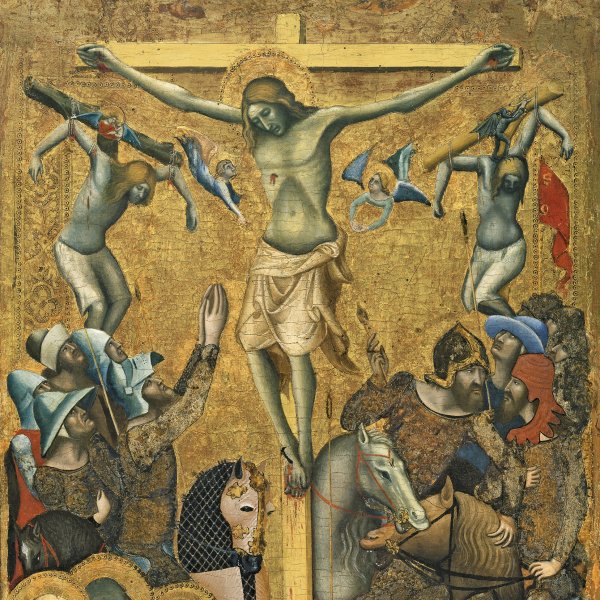The Nativity and other Episodes from the Childhood of Christ
ca. 1330
Tempera and gold on panel.
17.2 x 19.7 cm
Thyssen-Bornemisza Collection on deposit with the Museu Nacional d'Art de Catalunya (MNAC)
Inv. no.
321
(1979.63
)
Not on display
Level 2
Permanent Collection
Level 1
Permanent Collection
Level 0
Carmen Thyssen Collection and Temporary exhibition rooms
Level -1
Temporary exhibition rooms, Conference room and EducaThyssen workshop
This panel, was which formerly in the Dixon collection in the UK, was acquired by Baron Hans Heinrich Thyssen-Bornemisza in 1979. Despite its small size the artist was easily able to accommodate four scenes from
the childhood of Christ: The Nativity, The Infant Christ bathed, The Annunciation to the Shepherds and The Arrival of the Magi. Like many of the other Early Italian paintings
in the Collection, this panel originally formed part of a larger ensemble, in this case one that was dismantled before 1819. The panel was part of a triptych whose central panel had four elements and whose wings
had two each, according to Boskovits’ reconstruction. Various surviving elements have been identified including The Presentation in the Temple and The Burial of Christ (Gemäldegalerie, Berlin),
The Resurrectionand Noli me tangere (Cassa di Risparmio di Rimini on permanent deposit at the Museo della Città), and The Birth of the Virgin, recorded in the Berlin collection of Richard von Kaufmann in 1917.
Shared features of these panels include the haloes, with their large, concentric circles, as well as elements in the backgrounds, all of which are gold and have similar plants and trees. These similarities are more obvious in the treatment of the summary landscape in this painting and in The Burial of Christ: both share the progressive layers of rocky hills with their small, simply rendered trees. The vegetation in the foreground of The Burial of Christand that in the present panel is also comparable.
This panel was published as a work by Pietro da Rimini in the catalogue of the sale of the Dixon collection, which also included The Resurrection and Noli me tangere. The date of the panel was proposed by Boskovits, who saw a series of similarities between The Presentation in the Temple from the same ensemble (Berlin) and the frescoes in Santa Maria in Porto Fuori in Ravenna. Pietro da Rimini adhered to the Byzantine tradition for the iconography of the present panel. The Virgin is thus shown as lying on a mattress with the Child on her lap, while Saint Joseph is separated from this group, seated on the ground in a devotional pose and looking up at the Virgin and Child. At his side the two midwives Zelomi and Salome bathe the newborn Christ in a rustic wooden bath, an iconographic motif that disappeared in the 15th century for doctrinal and compositional reasons. The three Magi on horseback are located on the left, closing the composition on that side. The final episode is The Annunciation to the Shepherds, which takes place in the mountains. Although Pietro da Rimini used traditional motifs and a gold background, this composition also reveals clear innovations of a highly naturalistic type such as the gastural interaction between the Virgin, Christ and Melchior, as well the latter’s with the other Magi.
Mar Borobia
Shared features of these panels include the haloes, with their large, concentric circles, as well as elements in the backgrounds, all of which are gold and have similar plants and trees. These similarities are more obvious in the treatment of the summary landscape in this painting and in The Burial of Christ: both share the progressive layers of rocky hills with their small, simply rendered trees. The vegetation in the foreground of The Burial of Christand that in the present panel is also comparable.
This panel was published as a work by Pietro da Rimini in the catalogue of the sale of the Dixon collection, which also included The Resurrection and Noli me tangere. The date of the panel was proposed by Boskovits, who saw a series of similarities between The Presentation in the Temple from the same ensemble (Berlin) and the frescoes in Santa Maria in Porto Fuori in Ravenna. Pietro da Rimini adhered to the Byzantine tradition for the iconography of the present panel. The Virgin is thus shown as lying on a mattress with the Child on her lap, while Saint Joseph is separated from this group, seated on the ground in a devotional pose and looking up at the Virgin and Child. At his side the two midwives Zelomi and Salome bathe the newborn Christ in a rustic wooden bath, an iconographic motif that disappeared in the 15th century for doctrinal and compositional reasons. The three Magi on horseback are located on the left, closing the composition on that side. The final episode is The Annunciation to the Shepherds, which takes place in the mountains. Although Pietro da Rimini used traditional motifs and a gold background, this composition also reveals clear innovations of a highly naturalistic type such as the gastural interaction between the Virgin, Christ and Melchior, as well the latter’s with the other Magi.
Mar Borobia









